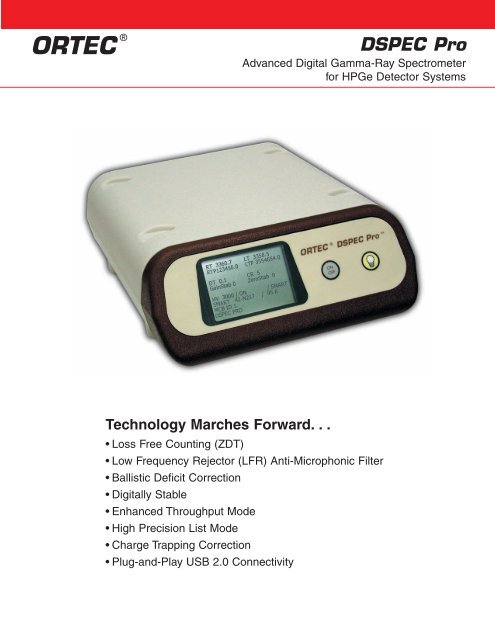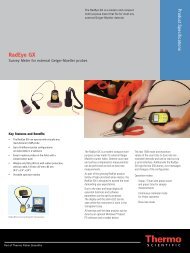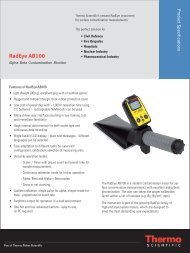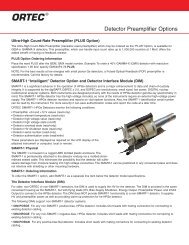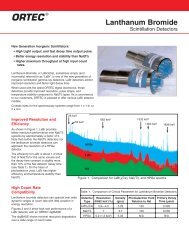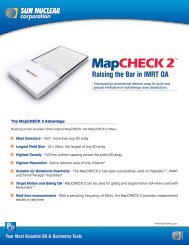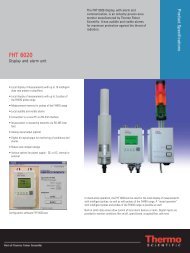You also want an ePaper? Increase the reach of your titles
YUMPU automatically turns print PDFs into web optimized ePapers that Google loves.
ORTEC ®<br />
<strong>DSPEC</strong> <strong>Pro</strong><br />
Advanced Digital Gamma-Ray Spectrometer<br />
for HPGe Detector Systems<br />
Technology Marches Forward. . .<br />
• Loss Free Counting (ZDT)<br />
• Low Frequency Rejector (LFR) Anti-Microphonic Filter<br />
• Ballistic Deficit Correction<br />
• Digitally Stable<br />
• Enhanced Throughput Mode<br />
• High Precision List Mode<br />
• Charge Trapping Correction<br />
• Plug-and-Play USB 2.0 Connectivity
<strong>DSPEC</strong> <strong>Pro</strong>: Advancing the Art of Digital Gamma-Ray Spectroscopy<br />
<strong>DSPEC</strong> <strong>Pro</strong> is the latest addition to the growing line of digital gamma-ray spectrometers from ORTEC. It has<br />
more performance features than any other HPGe gamma-ray spectrometer in existence, at any price. It<br />
represents a major evolutionary step in the ORTEC continuing investment in digital gamma-ray spectrometry<br />
system development.<br />
The immense versatility of <strong>DSPEC</strong> <strong>Pro</strong>, brought about by the number of unique features and modes of<br />
operation, means that it is an ideal solution for a wide variety of applications. Its neat and compact packaging<br />
further enhance its applicability.<br />
Digital spectrometers are inherently more stable than the analog variety of years gone by, and since the<br />
introduction of the original <strong>DSPEC</strong>, ORTEC has achieved the reputation as the supplier of instruments which<br />
represent the benchmark in stability, both relating to temperature and count rate.<br />
In introducing the <strong>DSPEC</strong> <strong>Pro</strong>, ORTEC has capitalized on this digital instrument platform and enhanced it in<br />
several unique ways which have distinct benefit in real-world applications.<br />
<strong>DSPEC</strong> <strong>Pro</strong> Features at a Glance<br />
For High-Rate Spectroscopy Applications<br />
"Loss Free" or "Zero Dead Time" (ZDT) 1<br />
The usual way to account for counting losses at high rates is through extending the acquisition time. The<br />
underlying assumption must be that the sample does not change during the extended period. This is far from<br />
true when short half lives are encountered or the sample is not stationary (e.g., flowing through a pipe).<br />
ORTEC has refined the loss-free counting technique in the digital domain. In this method, the spectrum itself<br />
is corrected pulse by pulse, and the ZDT method provides both an accurately corrected spectrum and<br />
correctly calculated statistical uncertainty.<br />
"Enhanced Throughput" Mode<br />
Accuracy at high input count-rates can be limited by the speed at which the spectrometer stores data to<br />
memory. It is said to be "throughput-limited". Pulse pileup means that beyond a certain point, as input countrate<br />
increases still further, the rate of data stored to memory DECREASES, reducing result quality. By<br />
developing a new kind of digital peak detector algorithm, ORTEC has increased the maximum throughput by<br />
up to 30% by removing some of the dead time associated with the process of pulse peak amplitude<br />
determination.<br />
1<br />
Patent No. 6,327,549<br />
2
<strong>DSPEC</strong> <strong>Pro</strong><br />
Advanced Digital Gamma-Ray Spectrometer<br />
for HPGe Detector Systems<br />
For Samples in Motion<br />
List Mode<br />
For situations in which the sample is moving relative to the detector, it is often vitally important to be able to<br />
measure an activity profile as a function of time. Examples of such applications include aerial and land-based<br />
surveying and portal monitoring. It is usually a requirement that no "dead periods" occur, associated with the<br />
acquire-store-clear-restart cycle. In the list mode of operation, data are streamed directly to the computer,<br />
event by event. There is no associated "dead period". In the <strong>DSPEC</strong> <strong>Pro</strong> implementation, each event is timestamped<br />
to an accuracy of 200 nanoseconds. Via the use of a programmers toolkit, data may be<br />
re-constituted into a spectrum for off-line analysis by one of ORTEC’s wide range of analysis software<br />
products or user-developed codes.<br />
For Hostile Environments and for Mechanical Coolers<br />
Low-Frequency Rejector (LFR)<br />
HPGe detectors do not, as a rule, perform well in environments where<br />
there is mechanical vibration. Microphonic noise degrades energy<br />
resolution by adding low frequency periodic electrical noise to the<br />
primary signal. Electrical ground loops are also a source of low<br />
frequency electrical noise. There is increasing use of mechanical<br />
coolers for HPGe detectors (to eliminate the need for LN 2 ) and the<br />
increasing need to take HPGe detectors out of the laboratory<br />
environment.<br />
<strong>DSPEC</strong> <strong>Pro</strong> incorporates a Low-Frequency Rejector (LFR) 2 Filter<br />
feature, which reduces the effects of such noise sources. Combined<br />
with high performance list mode, the <strong>DSPEC</strong> <strong>Pro</strong> is the instrument of<br />
choice for mobile vehicle survey systems.<br />
X-COOLER II Mechanical Cooler<br />
for HPGe Detectors<br />
For Enhancement of Resolution in Large or Neutron Damaged Detectors<br />
Ballistic Deficit and Charge Trapping Correction<br />
The trapezoidal digital filter in the <strong>DSPEC</strong> <strong>Pro</strong> is held in common<br />
with all other ORTEC <strong>DSPEC</strong> family members. It allows<br />
adjustment of the filter to optimize the resolution performance of<br />
large HPGe detectors which can often suffer low-side peak<br />
tailing if ballistic deficit is present. These large detectors are<br />
finding increasing use in low level counting applications.<br />
The adjustment is largely automated by the use of the<br />
"OPTIMIZE" feature and may be monitored by the InSIGHT<br />
digital oscilloscope mode.<br />
2<br />
Patent Pending<br />
InSight Oscilloscope Mode.<br />
3
The <strong>DSPEC</strong> <strong>Pro</strong> offers even further capability in the form of a charge trapping corrector which can be used to<br />
mitigate the peak degradation in the case of a neutron damaged detector. The neutron damage to the crystal<br />
lattice causes "trapping" centers which "hold onto" some of the charge created by the gamma-ray interaction.<br />
This results in low-side tailing similar to ballistic deficit although the cause is different. The charge trapping<br />
corrector is calibrated or "trained" such that it adds back the pulse height deficit, event by event.<br />
Other Important <strong>DSPEC</strong> <strong>Pro</strong> Benefits<br />
While in many respects <strong>DSPEC</strong> <strong>Pro</strong> is breaking new ground, ORTEC did not forget to carry over the benefits<br />
already proven in other ORTEC MCA products:<br />
Single-Cable Connection to your HPGe Detector<br />
<strong>DSPEC</strong> <strong>Pro</strong> uses the unique ORTEC Detector Interface Module (DIM) for a single-cable connection to the<br />
detector. The DIM is designed to supply bias close to the detector so the cable carries only signal and lowvoltage<br />
power — no longer is high-voltage bias, and the dangers associated with it, carried over long<br />
distances.<br />
SMART-1 Support<br />
<strong>DSPEC</strong> <strong>Pro</strong> has built in support for HPGe detectors which employ ORTEC<br />
SMART-1 technology. SMART-1 HPGe detector technology is a great<br />
advance in HPGe detectors and their operation. It is an enhancement to data<br />
and chain of custody integrity and an improvement in detector management<br />
practice and data control. A SMART-1 HPGe detector is "intelligent". The<br />
built-in controller monitors and reports on all vital system functions. Individual<br />
vital signs are available as well as the overall "state-of-health" (SOH). The<br />
detector controller "knows" who it is: each unit has its own identification serial<br />
number. To further increase data integrity, the controller can even store<br />
authentication codes and later return the code to ensure traceability of the<br />
data.<br />
During data acquisition, the SMART-1 detector monitors all of its own "vital<br />
functions". Should any of the monitored functions fall outside a specified<br />
range of values (even if they subsequently return to normal), the condition is<br />
registered and at the end of the acquisition the <strong>DSPEC</strong> <strong>Pro</strong> reads the SOH<br />
and displays a warning message if a problem was detected. No Message —<br />
no problem.<br />
SMART-1 Detector with Detector<br />
Interface Module (DIM).<br />
Support for Sample Changers<br />
A simple to use hardware TTL port is provided for support of sample changer<br />
systems.<br />
ASC2 Sample Changer<br />
4
Connections to the <strong>DSPEC</strong> <strong>Pro</strong><br />
<strong>DSPEC</strong> <strong>Pro</strong><br />
Advanced Digital Gamma-Ray Spectrometer<br />
for HPGe Detector Systems<br />
The <strong>DSPEC</strong> <strong>Pro</strong> provides high speed control via standard USB 2.0 to any Windows 2000/XP system. The<br />
plug-and-play feature makes installation simple. A nearly unlimited number of <strong>DSPEC</strong> <strong>Pro</strong> or other ORTEC<br />
USB instruments can be connected simultaneously using USB hubs. As an ORTEC CONNECTIONS-32<br />
compatible instrument, <strong>DSPEC</strong> <strong>Pro</strong> works in a networked and a stand-alone configuration. ORTEC<br />
CONNECTIONS-32 means: any hardware, any software, anywhere in the laboratory with full seamless control<br />
and built-in security.<br />
5
Specifications<br />
Display: 240 x 160 pixel backlit LCD provides<br />
status information, instrument ID, bias information,<br />
live and real time.<br />
Concurrent Connections: Limited by the computer<br />
and supporting USB hubs. ORTEC<br />
CONNECTIONS-32 software supports up to 127<br />
USB-connected devices per computer.<br />
System Gain Settings:<br />
Coarse Gain: 1, 2, 4, 8, 16, or 32.<br />
Fine Gain: 0.45 to 1.<br />
The available range of gain settings supports all<br />
types of HPGe detectors. Specifically the following<br />
maximum energy values are achievable using the<br />
standard ORTEC preamplifier (max gain to min<br />
gain):<br />
COAX<br />
187 keV to 12 MeV<br />
LO-AX<br />
94 keV to 6 MeV<br />
GLP/SLP 16.5 keV to 1 MeV<br />
IGLET-X 8 keV to 500 keV<br />
Preamplifiers: Computer selectable as either<br />
resistive or TRP preamplifier.<br />
System Conversion Gain: The system conversion<br />
gain is software controlled from 512 to 16k<br />
channels.<br />
Digital Filter Shaping-Time Constants:<br />
Rise Times: 0.8 µs to 23 µs in steps of 0.2 µs.<br />
Flat Tops: 0.3 to 2.4 in steps of 0.1 µs.<br />
Dead-Time Correction: Extended live-time<br />
correction according to Gedcke-Hale method.<br />
Accuracy: Area of reference peak changes
<strong>DSPEC</strong> <strong>Pro</strong><br />
Advanced Digital Gamma-Ray Spectrometer<br />
for HPGe Detector Systems<br />
Inputs and Outputs<br />
Detector: Multipin connector (13W3) with the<br />
following:<br />
Preamp Power: 1 W maximum (+12 V, –12 V,<br />
+24 V, –24 V, 2 GND).<br />
Amp In: Normal amplifier input.<br />
TRP Inhibit.<br />
Power for SMART-1 or DIM.<br />
Control of HV and SMART-1 Detector (2 wires).<br />
USB: Universal serial bus for PC communications.<br />
Power: Connection to supply power from a wall<br />
mounted dc supply. (+12 V dc
Ordering Information<br />
Model<br />
<strong>DSPEC</strong> PRO<br />
<strong>DSPEC</strong> PRO-POSGE<br />
<strong>DSPEC</strong> PRO-NEGGE<br />
<strong>DSPEC</strong> PRO-POSNA<br />
<strong>DSPEC</strong> PRO-296<br />
<strong>DSPEC</strong> PRO-PKG-1<br />
<strong>DSPEC</strong> PRO-PTK<br />
Additional DIMS<br />
DIM-POSGE<br />
DIM-NEGGE<br />
DIM-POSNAI<br />
DIM-296<br />
Description<br />
<strong>DSPEC</strong> <strong>Pro</strong><br />
Advanced Digital Gamma-Ray Spectrometer<br />
for HPGe Detector Systems<br />
<strong>DSPEC</strong> <strong>Pro</strong> with MAESTRO-32 Software, No DIM, for use with SMART-1<br />
equipped detector.<br />
<strong>DSPEC</strong> <strong>Pro</strong> with MAESTRO-32 Software and DIM-POSGE for use with<br />
Non-SMART-1 detector.<br />
<strong>DSPEC</strong> <strong>Pro</strong> with MAESTRO-32 Software and DIM-NEGGE for use with<br />
Non-SMART-1 detector.<br />
<strong>DSPEC</strong> <strong>Pro</strong> with MAESTRO-32 Software and DIM-POSNAI for use with<br />
NaI detector.<br />
<strong>DSPEC</strong> <strong>Pro</strong> with MAESTRO-32 Software and DIM-296 for use with<br />
NaI detector.<br />
<strong>DSPEC</strong> <strong>Pro</strong> with MAESTRO-32 and GammaVision-32 Software, No DIM,<br />
for use with SMART-1 equipped detector.<br />
<strong>DSPEC</strong> <strong>Pro</strong> with MAESTRO-32 and A11-B32 Software, No DIM, for use<br />
with SMART-1 equipped detector.<br />
Detector Interface Module for ANY Non-SMART positive bias HPGe detector<br />
Detector Interface Module for ANY Non-SMART negative bias HPGe detector<br />
Detector Interface Module for ANY positive bias NaI detector<br />
Detector Interface Module with Model 296 ScintiPack tube base/preamplifier/<br />
bias supply for NaI detectors with 14-pin, 10 stage photomultiplier tubes.<br />
Example System Order:<br />
<strong>DSPEC</strong> <strong>Pro</strong><br />
GEM80P4<br />
SMART-1-P<br />
CFG-X-COOL-II-115<br />
Specifies a <strong>DSPEC</strong> <strong>Pro</strong>; 80% GEM PopTop detector with SMART-1 technology; and an X-COOLER II.<br />
ORTEC<br />
®<br />
www.ortec-online.com<br />
Tel. (865) 482-4411 • Fax (865) 483-0396 • ortec.info@ametek.com<br />
801 South Illinois Ave., Oak Ridge, TN 37831-0895 U.S.A.<br />
For International Office Locations, Visit Our Website<br />
Specifications subject to change<br />
050707


